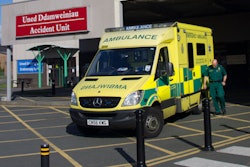
Two researchers have presented detailed analysis of 10 cases involving errors by radiology trainees in their preliminary reports during out-of-hours cover. The authors' aim is to reframe mistakes into a learning opportunity for others and provide practical suggestions on how to reduce future errors.
"We highlight radiology trainees' report errors in our institute to outline blind spots and commonly missed pathology in the interpretation of emergency CT imaging," noted Drs. R.X.-G. Man and A. Varma, from Brisbane, Queensland, in an e-poster presentation at last week's Royal Australian & New Zealand College of Radiology (RANZCR) annual scientific meeting. "Learning from mistakes is an important tool to become a better radiologist."
The duo retrospectively identified errors in the preliminary reports issued by radiology trainees during out-of-hours reporting in a tertiary referral hospital. They selected images to show missed pathologies or false interpretations.
Details of the 10 cases are given below. Also, you can view the 26 clinical images from these cases by going to the link for the authors' poster on the RANZCR section of the Electronic Presentation Online System (EPOS) on the European Society of Radiology's website.
Case 1: 60-year-old woman with shortness of breath and intermittent chest pain. Axial CT pulmonary angiography (CTPA) demonstrated faint peripheral areas of non-opacification of the right middle lobe segmental pulmonary artery thought to be secondary to pulmonary embolism in the preliminary report. "This is favored to be secondary to cardiac motion artifacts with partial volume of the adjacent pulmonary parenchyma mimicking a filling defect," the authors wrote. The differential diagnosis of chronic thromboembolic pulmonary hypertension was raised and would be best demonstrated on modalities such as a ventilation/perfusion lung scan or MR pulmonary perfusion/MR angiography. Final diagnosis: no pulmonary embolism; no features of chronic thromboembolic pulmonary hypertension; false-positive CTPA study.
Case 2: An 87-year-old woman with chest pain and hypertension who was diaphoretic. History of sternotomy, ascending aortic aneurysm, and aortic valve repair six months prior. The preliminary report recognizes the presence of surgical material at the proximal arch with dense coronary arterial calcifications. A moderate volume pericardial effusion was present overlying the left ventricle and was thought to be stable postoperative changes. The preliminary reports concluded with no aortic dissection and moderate volume pericardial effusion. The presumed 98 x 30 mm posterior pericardial effusion is hyperdense (46 Hounsfield units), with a small focus of contrast extravasation (no corresponding calcification on precontrast CT) detected arising from a small obtuse marginal branch overlying the basal inferolateral left ventricle. The pericardial effusion was loculated, causing mass effect by effacing the left ventricular apex, which was concerning for hemopericardium and cardiac tamponade.
Case 3: A 53-year-old man who had a fall two weeks previously and presented with a constant headache. Noncontrast CT head coronal and axial images demonstrated a left cerebral convexity isodense subdural hematoma and nondisplaced fracture of the left temporal bone, which were not seen by the reporting registrar and were subsequently identified by the radiologist the next morning.
Case 4: CT thoracic spine on an elderly nursing home resident presented with mid-thoracic spine tenderness after a fall. Multilevel fractures involving C7, T1, T2, and multilevel insufficiency fractures of the thoracic vertebra were identified. Failure to compare with available prior studies resulted in the lack of appreciation of the new C7/T1 fractures. Old sternal fractures in two places were also noted.
Case 5: Noncontrast CT head was carried out on an elderly patient who had an unwitnessed fall and delirium. A small focus of hyperdensity overlying the left frontal lobe middle gyrus was not identified by the registrar in keeping with traumatic subarachnoid hemorrhage. Note was made of subtle thin bifrontal isodense subdural hygromas. Careful windowing to demonstrate subtle density differences between the cerebrospinal fluid and extra-axial collection were suggested.
Case 6: History: acute confusion; possible recent fall; lump on left forehead. There was a need to exclude a bleed. The preliminary report concluded there was no acute intracranial hemorrhage or fracture. A small left frontal scalp hematoma was identified. A partial effusion of the right mastoid air cell was missed. A nondisplaced longitudinal fracture of the right temporal bone without otic capsule involvement was identified subsequently. Small gas locules within the sigmoid sinus with suspicion of sigmoid venous sinus thrombosis prompted subsequent MRI evaluation. The fracture is better appreciated on maximum intensity projection images. A subsequent brain MRI scan of the same patient demonstrated a small subdural hematoma indenting the transverse sinus. No dural venous sinus thrombosis.
Case 7: Portal venous CT abdomen and pelvis of a 74-year-old man with one day history of left-sided abdominal pain. The registrar correctly identified an epiploic appendagitis of the mid-distal descending colon (coronal image). However, a left lower lobe segmental pulmonary embolism was not seen at the edge of the scanned volume. This was recognized by the radiologist and confirmed on subsequent CTPA.
Case 8: History provided: 60-year-old female with vertigo; peripheral vs. central. The conclusion in the preliminary report was that noncontrast CT demonstrated no intracranial bleeding. Dehiscence of the right superior semicircular canal was subsequently identified, raising suspicion of superior semicircular canal dehiscence syndrome.
Case 9: A Glasgow Coma Scale score of 8 was noted after neck of femur fracture surgery. Reduced movements of the right upper and lower limb and equivocal right plantar reflex were visible. A CT head scan was carried out to exclude hemorrhage or stroke. The registrar did not identify the small wedge-shaped hypodense area of the superior aspect of the left parietal lobe along the intraparietal sulcus. Loss of grey-white matter differentiation at the cortex with effacement of the adjacent sulcal spaces was demonstrated, correlating to the clinical history, consistent with an acute infarct.
Case 10: Right occipital fracture and underlying extradural hemorrhage. There was a need to exclude transverse sinus thrombus. CT head venogram demonstrated a right occipital epidural hematoma, which was stable in size compared to the initial trauma CT head scan. The registrar did not identify a venous sinus thrombosis. Subsequently, the radiologist identified a partial filling defect within the right transverse sinus which was not appreciated on previous CT and MR images one year prior, along with nondisplaced fracture at the site in keeping with a nonobstructive transverse sinus.
Developing a safety culture
Using errors as a learning exercise in a no-blame context is important, commented Dr. Catherine Mandel, MRI radiologist at Swinburne University of Technology, Melbourne, Australia, who was the lead radiologist with the now-disbanded Radiology Events Register (RaER) and national liaison radiologist for the Quality Use of Diagnostic Imaging Prgoram (QUDI), also disbanded.
"It is very good that this new poster from Brisbane highlights the importance of not apportioning blame and that there is recognition that error can happen to anyone. This is an important first step in developing a safety culture, which is critical to improving patient safety," she told AuntMinnieEurope.com.
The essential aspect is to understand why errors occur and to put steps in place to mitigate, and preferably eliminate, the risk, according to Mandel.
"This poster shows a variety of missed findings and misinterpretations, as in case 1 for example. A few of the authors' cases gave good explanations of specific mitigating actions -- e.g., look at the old imaging," she said. "It does not discuss the systemic reasons why these errors occurred or what was done to mitigate the risk of recurrence."
Mandel said she would have been thinking more broadly about why the errors occurred -- fatigue, situational awareness, back-of-clock working hours, interruptions, etc.
"Understanding the factors underlying these errors is the first step in developing ways to decrease errors," she added. "There is the assumption that the consultants did not miss anything: learning from errors is important throughout our careers."

















